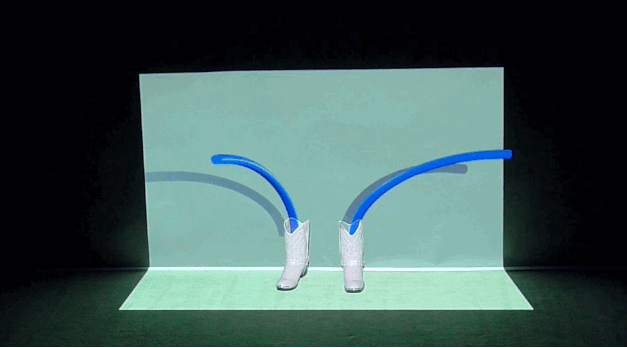In the 1970's, as video was first being used by artists, John Baldessari quipped that using video would one day be as common as using a pencil. Today, it might be harder to find an artist using a pencil than a video camera. Young Projects, located in the Pacific Design Center, is a gallery dedicated to video art started by former art writer Paul Young.

Stas Orlovski, "Figure with Waterfall," 2015
Wood, stop-motion animation and sound, 85 X 70 inches
Sound by Steve Roden
Post production by Beau Leduc
Shows by three artists there are indicative of the varied uses of video and its global reach. Stas Orlovsky, born in Moldavia, now living in LA, has transferred his talent at collage using elements from 19th century prints, to video. In this show Stazka, he animates those fragments from old engravings, at times using stop action methods to create a theatrical environment reminiscent of a19th century magic lantern show.

Stas Orlovski, "Composition with Figures and Mirror," 2015
Wood, stop-motion animation and sound, dimensions variable
Sound by Steve Roden
Post production by Beau Leduc
The darkened gallery features a half a dozen cut-out shapes of white board, mounted on wooden bases, that serve as the projection screens for his constantly changing arrangements of landscape, embroidery patterns or migrating swallows borrowed from vintage illustrations and enhanced by his own talents in drawing and painting. The result is a warm, hand-built installation that is a refreshing alternative to the more ubiquitous digitally-driven video art. The sound design accompanying the installation was composed by Steve Roden, who will be performing there on the evening of January 22.

Egill Sæbjörnsson, "Out of Shoes Humans Grow," 2014
Single-channel video projection, cowboy boots and sound
Egill Sæbjörnsson, painter and musician from Reykjavik, Iceland and now living in Berlin, is known for putting animated expression onto inanimate objects, a technique known as "projection mapping." The show, P.L.A.Y. with Things, includes a number of pieces but the most exceptional is Out of Shoes Humans Grow (2014), a single pair of pale pink cowboy boots digitally inhabited by a pair of personable and, if you can believe it, amusing blue tubes that weave and duck and snuffle around like friendly snakes. Sometimes simplicity itself is captivating.

Julie Weitz, "Aftermath," 2015
1-channel video
Color with an original score by Deru; aspect ratio 16:9. dimensions variable
7 min 40 sec loop
Ed ¼
Far from simple is the Touch Museum, an elaborate series of videos reflected in mirrored walls by Julie Weitz, who lives in LA. A practicing painter until embarking on video in 2009, Weitz deftly combines identifiable and atmospheric elements in a rich range of controlled colors. Weitz's videos are inspired by a condition called ASMR, (Autonomous Sensory Meridian Response) whereby a viewer can be physically and emotionally affected by seeing a video of hair being brushed, a phenomenon on You Tube. The show includes a double-sided screen of Weitz's own curly mop of hair being gently touched by a disembodied hand to soft melodic sounds. You can walk around the screen in such a way that the effect seems quite private, intimate. The largest screen, doubled by its reflection in a mirror, features glittering bells, a carved head, clouds of colored smoke. The sound elements of the installation were created by composer/producer Benjamin Wynn, known as Deru.

Screen grab from Stas Orlovski's "Skazka"
Sound by Steve Roden | Post-Production by Beau Leduc
Inspired by the magical projections of 18th & 19th century
The entrance to gallery is called "Inside the Image (Chains)" and the floor is covered with magenta foam while chains hang from the ceiling, chains that then appear enlarged in her video. Weitz is interested in what she calls "digital humanism" and the emphasis of her Touch Museum is non-narrative and sensory but it might be said that all three artists at Young Projects explore the ways in which video can be pushed beyond superficial limitations of the medium itself. All the shows are on view through February 22.
All images are courtesy of Young Projects Gallery.
